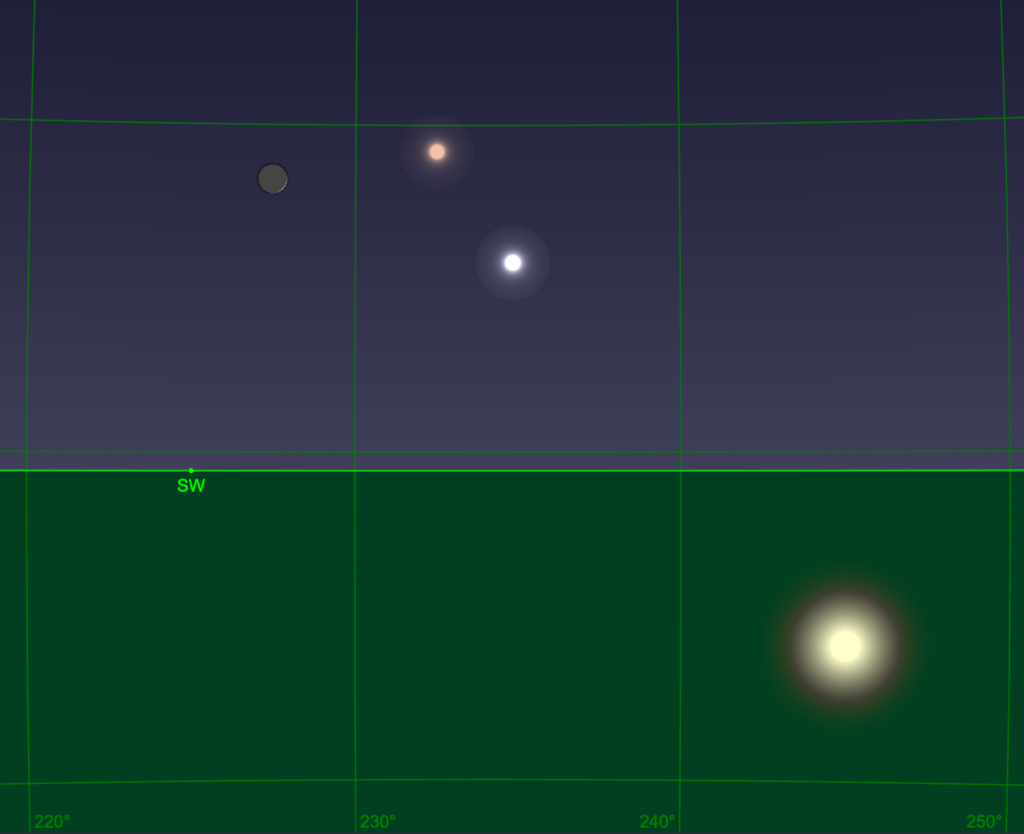Sky Report: December 19- 25, 2022

This is the scene 30 minutes after sunset (the horizon is translucent) on Saturday the 24th. Venus is brilliant. To the upper left of Venus is Mercury, only 1/20th as bright. The very thin crescent moon is to the left of Mercury. The grid lines are spaced 10° apart. Graphic created with SkySafariAstronomy.com.
All five naked-eye planets are out and in the evening sky this week and next if you have a dead flat southwest horizon and binoculars. And the moon joins them from the 24th. Here’s how to see them.
Two planets are brighter than any stars and they dominate the evening sky. They are Mars and Jupiter, and once the sky is fully dark orange Mars is a third of the way up the eastern sky while Jupiter is halfway up the southern sky. As the hours pass and the sky turns overhead Jupiter moves lower and to the west (setting around midnight) while Mars rises higher and is due south and nearly overhead an hour before midnight, not setting in the west until around 6 a.m. Mars is in Taurus, not far from the orange star Aldebaran and north of Orion, while Jupiter is in Pisces, a constellation with no bright stars.
Saturn is 40° to the lower right of Jupiter, so in deep twilight it is no more than 30° high in the southwest. It’s as bright as the brighter stars so it doesn’t really stand out. Remember that your fist held at arm’s length spans 10° and the width of a finger is about 2°.
Meanwhile Venus, which has been behind the sun since August, is very slowly returning to view, and this is the first week when you might see it. It’s very low in the west-northwest, only a few degrees above the horizon, but its great brilliance (4 times as bright as Jupiter) helps you see it. Look on Saturday the 24th when it’s a scant 6° high 30 minutes after sunset. It will definitely be a challenge naked-eye but easy with binoculars.
Once you find Venus, look for Mercury. On the 24th Mercury is 4° above Venus at the 11 o’clock position. Mercury is only 1/20th as bright as Venus so it will be a real challenge.
Also on that Saturday evening the ultra-thin crescent moon is 5° straight to the left of Mercury. Again, use binoculars – you’ll need them. And congratulate yourself if you see all three – Sky Report readers enjoy a challenge.
Mercury is relatively stationary against the background stars for the following few days but Venus is moving eastward relative to the stars and Mercury, and the two planets are much closer next week. More on that then.
Winter begins at 2:48 p.m. MST on the afternoon of the 21st when the sun reaches its southernmost point in the sky at the winter solstice. The sun rises and sets as far south as it will during the year and its noontime elevation is at its lowest (in the northern hemisphere). This is the shortest day of the year – 9h 37m at the latitude of Kanab. For stargazers, it’s the longest night! Seasons happen because the earth is tilted on its axis; Google “winter solstice” for a complete explanation; I especially like the Farmer’s Almanac: https://www.farmersalmanac.com/winter-solstice-first-day-winter.
Stellar Vista Observatory provides portable telescopes and tripod mounted binocular kits on loan for free to residents and visitors in Kane County. Enhance your enjoyment of the night sky! For details or to request a loan, visit https://stellarvistaobservatory.org/discover-the-night-sky/ or drop in to the Kane County Office of Tourism.
The Sky Report is presented as a public service by the Stellar Vista Observatory, a nonprofit organization based in Kanab, Utah, which provides opportunities for people to observe, appreciate, and comprehend our starry night sky. Additional information is at www.stellarvistaobservatory.org. Send questions and comments to John@StargazingAdventures.org.






Comments are closed.